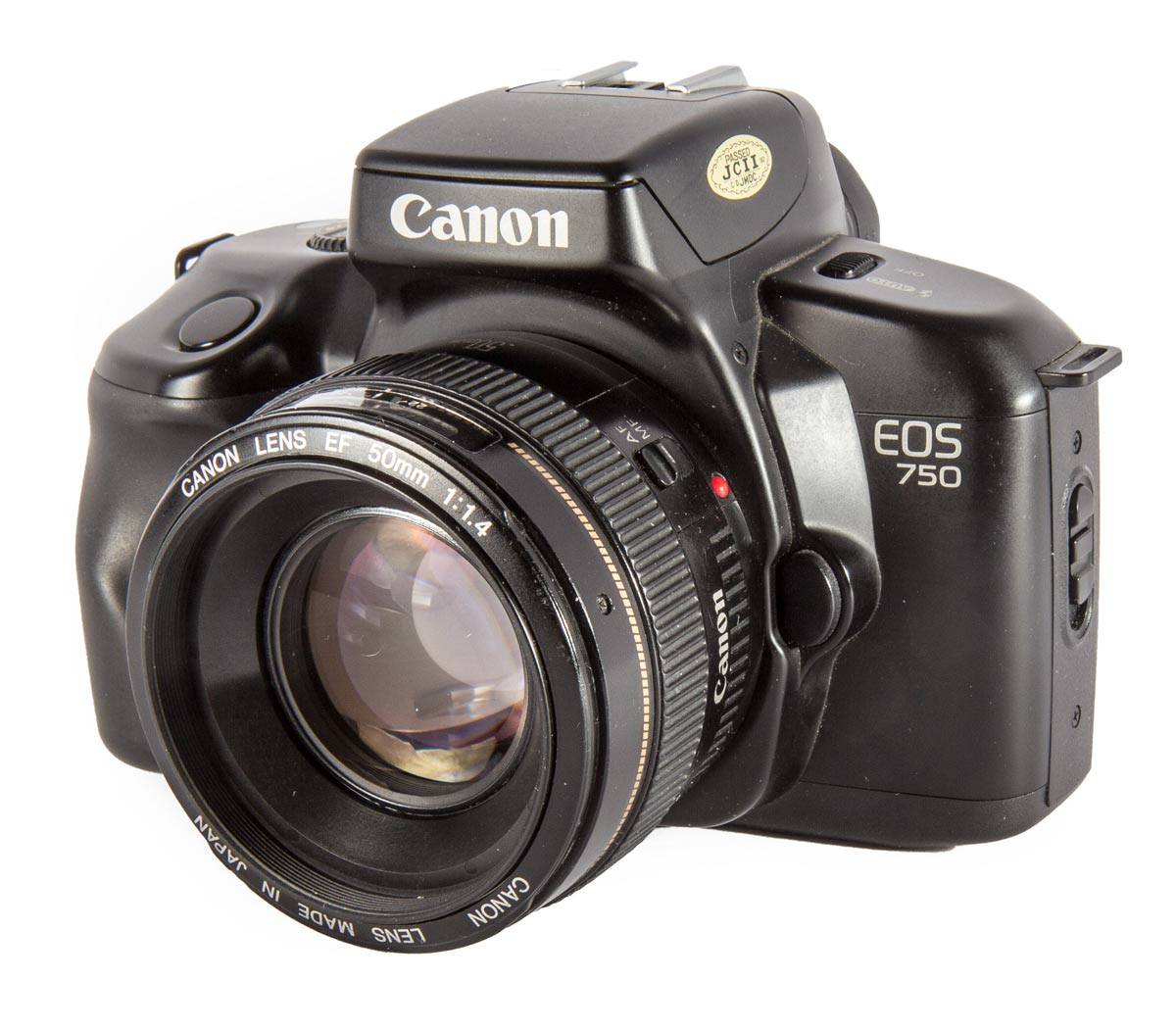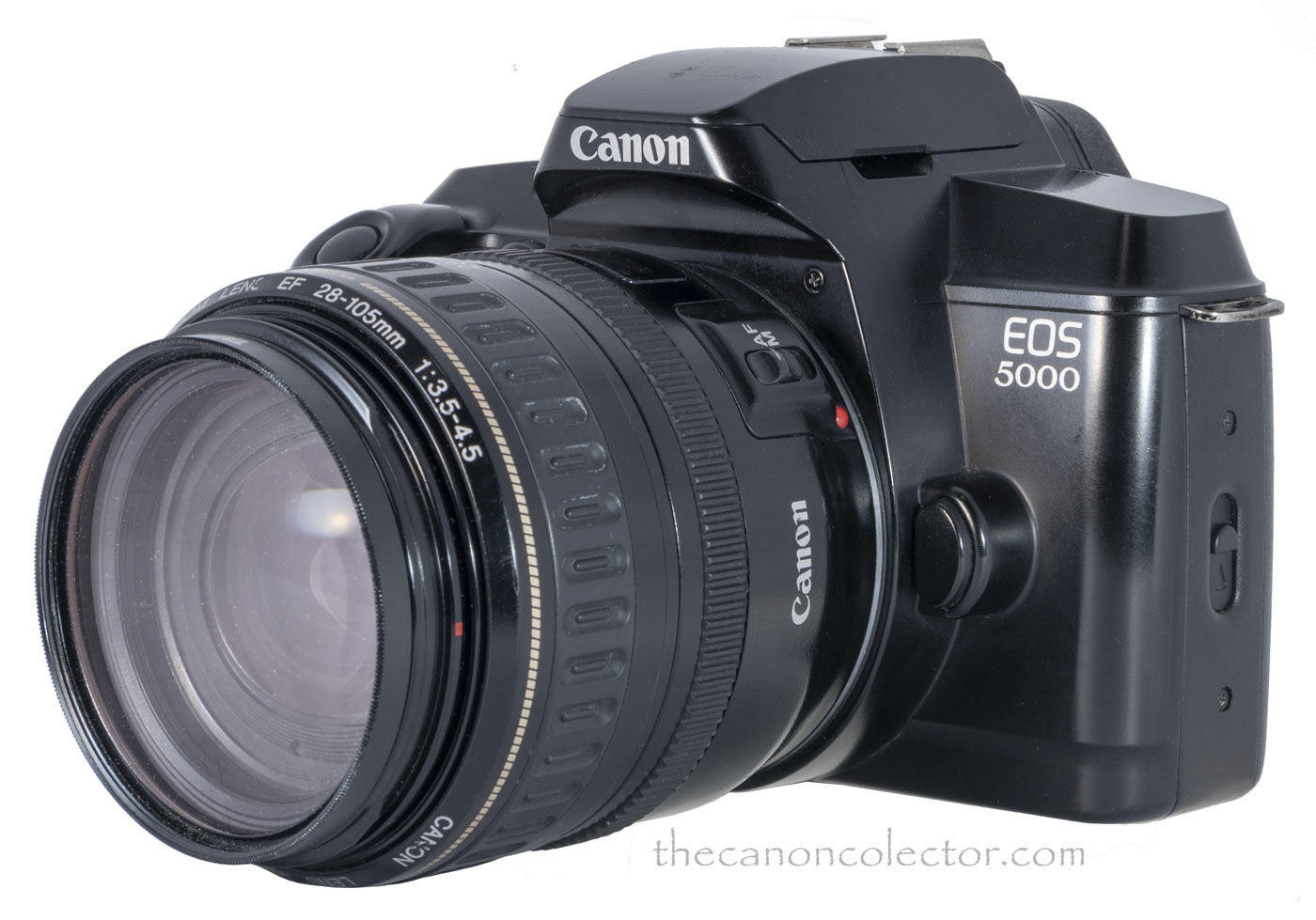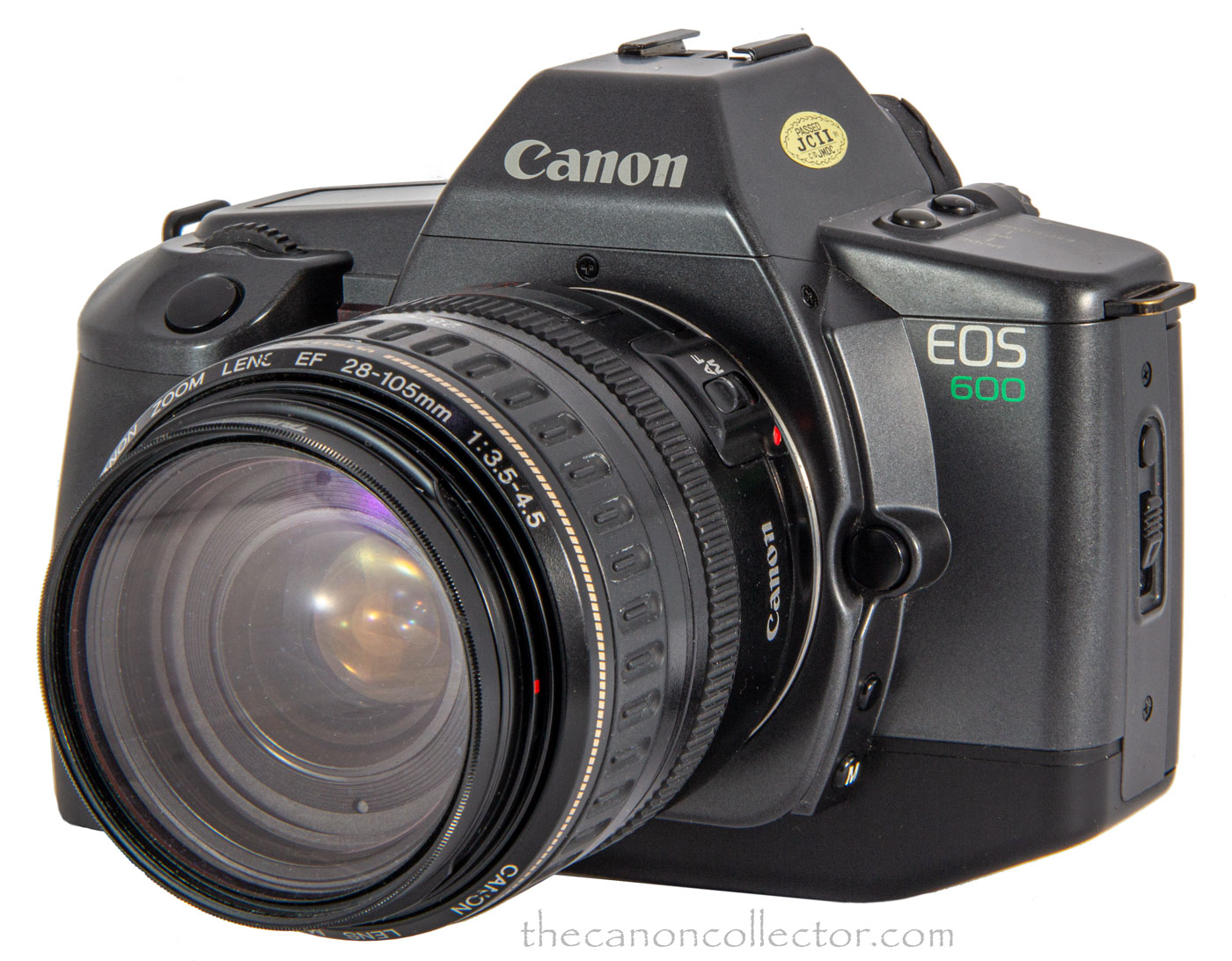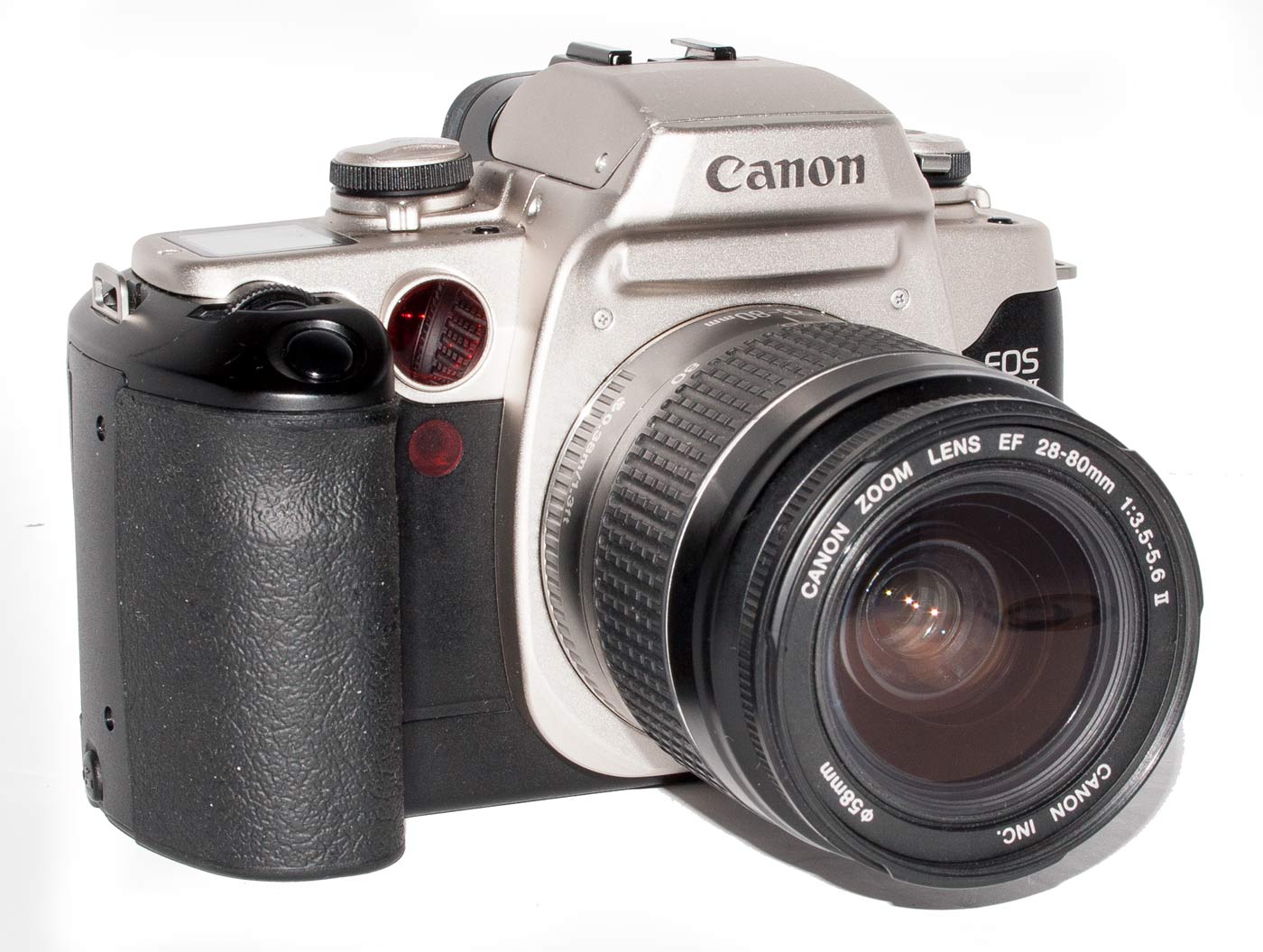
The EOS 888 is an entry level EOS film camera from 1995.
EOS Film Cameras
The Beginning of the End for Film
With the advent of the EOS film camera the manual focusing FD lens mount was supplanted by the EF mount and its derivatives, the EF-S and RF mounts. It surprises many people that the first EOS cameras were built for film.
Auto focus, TTL metering and many other advanced features predate the digital revolution in photography.
Shooting with the Canon T90, one of the last FD lens mount cameras, is very much a digital experience. Exposure is automatic. Focus is automatic. And film advance is instantaeous and silent. The only thing you can’t do is see your image on the back of the camera! The T90 even looks like an EOS camera.
The smooth round styling of the T90 clearly presage the EOS cameras that are a year or two away. As it does not have a pop-up flash mounted over the pentaprism like the EOS 888 has the T90 looks more like the EOS 1 introduced in 1989.

The Canon T90 is an FD film camera from 1986 that bears a strong resemblance to the smooth design of the EOS cameras to follow.
The first EOS was the EOS 650 which was introduced in March of 1987, a year after the T90. Canon’s first digital EOS camera, the D30 was not introduced until late 2000, 13 years later. And film continued for a while after that. Until you get to about 10 megapixels film is still the better medium. That did not happen until 2002 with the EOS 1D. The last film EOS was the Rebel T2 which was introduced in July of 2004.
The EOS 888 was introduced in January of 1995 almost 10 years before the end of the Canon film cameras.
Canon’s marketing of their EOS cameras has caused great confusion in model designations. For reasons apparently
known only to the marketing gurus, the same camera was often called by different names in North America, Japan and the rest of the world. This gives rise to much confusion. In the chart below I try to clarify the names and dates. Three columns give the names in the various regions and one gives the approximate date of introduction.settings.
Cameras I have in the Collection are indicated in light blue and those I am still seeking have a white background.
Here is a list of the EOS film cameras and their dates of introduction. I have marked the ones I have acquired in a light blue.
| International | North America | Japan | Introduced |
| EOS 650 | EOS 650 | EOS 650 | Mar 1987 |
| EOS 620 | EOS 620 | EOS 620 | May 1987 |
| EOS 650 QD | EOS 650 QD | EOS 650 QD | Sep 1987 |
| EOS 750 | EOS 750 | EOS 750 | Oct 1988 |
| EOS 750 QD | EOS 750 QD | EOS 750 QD | Oct 1988 |
| EOS 850 | EOS 850 | EOS 850 | Oct 1988 |
| EOS 600 | EOS 630 | EOS 630 QD | Apr 1989 |
| EOS 1 | EOS 1 | EOS 1 | Sep 1989 |
| EOS RT | EOS RT | EOS RT | Oct 1989 |
| EOS 700 | EOS 700 | EOS 700 QD | Mar 1990 |
| EOS 1000 | EOS Rebel | EOS 1000 QD | Oct 1990 |
| EOS 1000F | EOS Rebel S | EOS 1000 QD-P | Oct 1990 |
| Rebel S QD | Oct 1990 | ||
| EOS 10 | EOS 10S | EOS 10 QD | Aug 1991 |
| EOS 100 | EOS Elan | EOS 100 QD | Aug 1991 |
| EOS 1000F QD | EOS Rebel S II | EOS 1000S QD | Mar 1992 |
| EOS 1000F N | EOS Rebel II | Mar 1992 | |
| EOS 1000F N QD | Mar 1992 | ||
| EOS 5 | EOS A2 | EOS 5 QD | Nov 1992 |
| EOS A2e | Nov 1992 | ||
| EOS 500 | EOS Rebel XS | EOS Kiss | Sep 1993 |
| Rebel X | Nov 1993 | ||
| EOS 1N | EOS 1N | EOS 1N | Nov 1994 |
| EOS 5000 | EOS 888 | Jan 1995 | |
| EOS 1N RS | EOS 1N RS | EOS 1N RS | Mar 1995 |
| EOS 50 | EOS Elan II | EOS 55 | Sep 1995 |
| EOS 50E | EOS Elan IIE | Sep 1995 | |
| EOS 500N | EOS Rebel G (Silver) | New EOS Kiss (Silver) | Sep 1996 |
| EOS Rebel G (Black) | Sep 1996 | ||
| EOS Rebel G QD | Sep 1996 | ||
| EOS IX | EOS IX | EOS IX E | Oct 1996 |
| EOS IX 7 | EOS IX Lite | EOS IX 50 | Mar 1998 |
| EOS 3 | EOS 3 | EOS 3 | Nov 1998 |
| EOS 3000 | EOS 88 | Mar 1999 | |
| EOS 3000 QD | EOS 88 QD | Mar 1999 | |
| EOS 300 | EOS Rebel 2000 | EOS Kiss III | Apr 1999 |
| EOS 300 Date | |||
| EOS 1V HS | EOS 1V HS | EOS 1V HS | Jan 2000 |
| EOS 1V | EOS 1V | EOS 1V | Jan 2000 |
| EOS 33 | EOS Elan 7 | EOS 7 | Oct 2000 |
| EOS 30 | EOS Elan 7E | Oct 2000 | |
| EOS Kiss III L | Sep 2001 | ||
| EOS 3000N | EOS Rebel XS N | EOS 66 | Feb 2002 |
| EOS 300V | EOS Rebel Ti | EOS Kiss 5 | Sep 2002 |
| EOS Rebel G II | Mar 2003 | ||
| EOS 3000V | EOS Rebel K2 | EOS Kiss Lite | Jul 2003 |
| EOS 30V/33V | EOS Elan 7 NE/Elan 7N | EOS 7S | Mar 2004 |
| EOS 300X | EOS Rebel T2 | EOS Kiss 7 | Jul 2004 |
The problem with this chart is that all of the EOS film cameras are lumped into one basket. This is confusing because the cameras were targeted to specific markets which is not obvious here. And the dates of introduction are somewhat hard to visualize.
Another way to look at this chart is to divide the cameras by target market and then show the dates of introduction graphically. This gives a chart that is much more easily grasped. As you work your way through the EOS film cameras you will refer to this chart often to see where particular cameras fit in.
I am sure there are inaccuracies in this list and I will try to track them down and correct them as time goes by. So lets work through these cameras.
Canon did not launch the EOS system and the EF lens mount on an entry level camera. In 1987 the came out with the 620 and 650, two very capable film cameras with features that placed them well into the enthusiast level. It was a year and a half before they introduced an ecomony entrance level camera body in the 750 / 850 body.
The 750 / 750 QD / 850 / 850 QD are all the same camera. The 850 is the basic camera and has no built in flash unit. The 750 is the same camera with a pop-up flash. The QD stands for “Quartz Date” and means the camera also has a Date Back for imprinting date on the film frame. These are smaller cameras with only one shooting mode; automatic. No other modes.
This was followed by the 700 and 700 QD which were much more full featured cameras with built in flash. These cameras are interesting because they were offered with the only detacheable power zoom lens Canon produced. After this camera all entry level cameras were also very capable cameras if somewhat short on advanced features.
In late 1990, Canon came out with the first Rebel camera. By this time Canan had arrived at the formula for their entry level cameras. They were intended for the amateur photographer looking for an entry level camera with sophisticated features or that person using a “point-and-shoot” who wanted something more. It was a good concept because here we are 27 years later and Rebels are still being sold as the entry level SLR in the Canon lineup.
The early film Rebels all featured very light weight curved black plastic body construction. They had fully computerized automatic functions but a reduced feature set. They used pentaprism viewfinders originally but later consumer models tended to go to the dimmer (and less expensive to manufacture) hollow mirror assemblies for the viewfinder.
But here the collector runs into a problem: the naming of the models. There were several models and each had several variations. And then there is the problem of different names in the Japanese, European and North and South American markets. To work through this we need a few conventions. The basic model name may have various suffixes.
| S | S signifies a model with built in flash | |
| F | F also signifies built in flash in the European market | |
| N | N is used to indicate a newer or improved model | |
| QD | Stands for Quartz Date which is a feature that imprints dates on the film | |
| P | P stand for Panorama which is a feature for producing panorama shaped images (this is a bit tacky because all it does is block the film top and bottom) | |
In October of 1990 Canon released the first Rebel (the EOS 1000 in Europe and Japan). It was also released as the Rebel S (1000F) which had a built in flash. I have seen references to a 1000 F-QD and a 1000 F-QD-P as well. Unfortunately, the internet is not always accurate. I have found many camera references which are incorrect. For some reason the Canon Museum is not helpful here. These early Rebels do not appear in their lists. As a result I am not certain which models actually exist. That is part of the fum of collecting. I will believe when I have a copy in my hands.
In March of 1992 a new model was released, the Rebel II (1000 N ) and the flash models, Rebel S II ( 1000 FN). And of course, there were some models with QD and QD-P indicated on them.
And then came the Rebel X, the XS, the G, 2000 and so on. I am still a little confused about the very early models, and I find that confusion on the Internet as I try to figure this out. But, as I find them I will update this description and it will all become clearer.
Before we look at the cameras, lets talk about the Date Back.
“QD” – The “Quartz Date” Back
You will see above that some cameras will have “QD” in their name. This stands for Quartz Date and these cameras have a special back on them that will imprint the date on each image, if you select that option. The back has a clock in it that keeps the date current once it is set and which will run as long as the CR2025 battery in the back has power. Battery life is usually 3 to 5 years. As a result, most QD backs no longer work but installing a new battery will usually cure this defect.
The QD Backs in the EOS film cameras are all very similar and operate the same way. The back needs a trigger pulse from the camera body to tell it when to imprint the film. This is done through electrical contacts at the top of the back which connect with the camera body when the back is closed. The light source (laser diodes?) flashes through cutouts in the pressure plate onto the film.
Of course, once the switch to digital came, each file contained metadata which included the date and time, amongst other things. There was no longer any need to take up valuable image space with the date.
These are the instructions from a manual for the Rebel G QD but they apply to most of the QD backs we are discussing.
The battery is easily removed and replaced. However, be sure to notice the polarity and insert the battery the right way up. That is, the positive side facing you.
“Entry Level” EOS Film Cameras
“Entry Level” does not mean cheap. Yes, they are less expensive cameras targeting people who what to get into a more serious camera without spending too much money. Cost is kept down by reducing features, using injectin moulded plastic, skipping the weather sealing found on more professional cameras. But for the intended audience they are excellent cameras. And as the category has matured they have become amazing cameras.
“Advanced Amateur” and “Enthusiast” EOS Film Cameras
Canon began the EOS line of cameras with the mid level EOS 650. They would go on to offer more advanced cameras, and simpler ones too, but they continued to offer cameras for the serious amateur. These cameras had most of the features of the top line cameras but were lighter build, had less weather proofing, possibly were not as smooth to operate. But they were fine cameras and capable of amazing photography.
Canon EOS Elan II
(also called the EOS 50 in Europe and the Elan 55 in Japan)
September 1995 – October 2000
Other EOS Film Cameras
![]() I am not in any way connected to or supported by Canon. I chose their camera line and have stayed with it. I cannot recall why. But a Nikon camera is fine technology and takes a wonderful picture. So too with Sony and the others. But I have been happy with Canon and so I have begun my collection here. One day I may add other brands to my range interest. But that is for another day.
I am not in any way connected to or supported by Canon. I chose their camera line and have stayed with it. I cannot recall why. But a Nikon camera is fine technology and takes a wonderful picture. So too with Sony and the others. But I have been happy with Canon and so I have begun my collection here. One day I may add other brands to my range interest. But that is for another day.








































